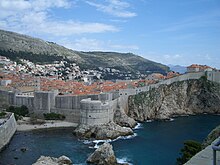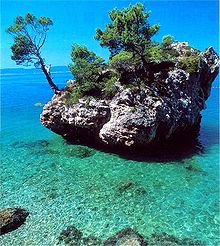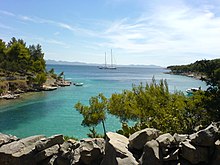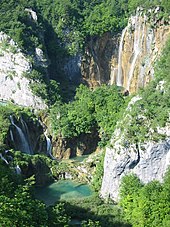Tourism in Croatia


The tourism is an important branch of the Croatian economy . The country is one of the most popular holiday destinations in Europe and has a long tradition in tourism. With around 16 million foreign visitors and 90 million overnight stays in 2016, Croatia is one of the most popular holiday destinations in the world. In the Travel and Tourism Competitiveness Report 2017 of the World Economic Forum, Croatia ranks 32nd out of 136 countries.
Eight areas were designated as nature reserves. The landscape of these areas received protection from development projects. Several companies operate flotillas of yachts along the coast, which is also popular among divers.
The motto The Mediterranean As It Once Was is used for advertising purposes.
Awards
2005, Croatia was internationally recognized by the publisher Lonely Planet for Destination of the Year chosen. As part of the Ethical Travel project from Berkeley , California , Croatia was chosen in 2008 as one of the ten most recommendable travel destinations among developing countries for ethical tourism. The criteria for compiling the list are environmental protection, human rights and social justice . In 2010 Croatia is no longer listed as the country is no longer considered a developing country according to the World Bank . The editorial team of National Geographic Adventure recently said that Croatia is one of the most longed for travel destinations with regard to the beauty of the Kornati Archipelago. The American Association of Tour Operators ( USTOA ) also announced at the end of 2005 based on the booking situation that Croatia would be one of the most popular travel destinations for Americans in 2006.
In 2007, Croatia took third place as the cheapest holiday destination in Europe, after Germany and Turkey. The survey was carried out by the ADAC.
History of tourism
Since the emergence of mass tourism in Europe at the end of the 19th century, Croatia, especially the Adriatic coast, has also been a popular destination for vacation trips. Croatia was already developed for tourism during the Habsburg Monarchy, but tourism on the Adriatic reached a temporary peak in the interwar period. Holidays in the Slavic brother state were particularly popular in the Czech Republic. After the Second World War, however, the tourism industry was unable to build on the interwar situation, as neither tourists from the Warsaw Pact countries nor from the NATO countries could enter Yugoslavia without any problems. However, Yugoslavia soon opened up to western tourism and advertised there aggressively. In the 1960s, the Eastern Bloc also opened up to Yugoslavia again and made it possible to enter the country with a quota. The nudist culture that had been cultivated in Croatia since the interwar period has now also been commercialized and institutionalized. After the end of the Tito regime and the general upheaval in Europe, tourism took a clear upturn, only slowed down by the Yugoslav wars of the 1990s.
Regions
Istria
The peninsula in northwestern Croatia is the driving force behind Croatian tourism and has many attractions. Along the western coast there are historic cities from Roman times, such as B. Umag , the home of the annual ATP Umag tennis tournament held on quartz sand courts . The city of Poreč is famous for the UNESCO-protected Euphrasian Basilica , which also contains the famous mosaics from the sixth century. Furthermore, the city map still shows ancient Roman castrum structure. Other important cities are Rovinj , Vrsar , Labin , Motovun , Rabac and Pazin . The largest city on the peninsula is Pula with the Roman amphitheater. The ancient amphitheater Pula is u. a. Venue of the Pula Film Festival . In addition, many concerts by local and international stars take place here.
Kvarner Bay
Along with Dalmatia in the south and Istria in the north, the Kvarner Bay is a very popular destination. Especially the coastal cities such as Opatija , Crikvenica and Novi Vinodolski as well as the offshore islands of Krk , Rab , Cres and Lošinj are among the largest tourist destinations in the region. The largest city in the Kvarner Bay is Rijeka . Rijeka is the starting point for sailors in the northern Adriatic. In the hinterland of the Kvarner Bay are the regions of Gorski Kotar and Lika . The Lika is u. a. known from the Plitvice Lakes National Park and the Velebit Mountains.
Dalmatia
The region is best known for its tourist resorts Zadar , Šibenik , Trogir , Split , the Makarska Riviera , Dubrovnik and the islands of Brač , Hvar , Korčula and Mljet . Numerous UNESCO World Heritage Sites can be discovered here. In addition, the Kornati archipelago off Zadar is a popular destination for sailing trips.
National parks
There are eight national parks and eleven nature parks in Croatia, which are also tourist magnets.
The national parks (according to the number of visitors, number of visitors January-September 2011):
- Plitvice Lakes National Park - 1.012058 visitors
- Krka National Park - 655104 visitors
- Brijuni National Park - 143006 visitors
- Paklenica National Park - 107,151 visitors
- Mljet National Park - 92778 visitors
- Kornati National Park - 82,380 visitors
- Northern Velebit National Park - 17218 visitors
- Risnjak National Park - 17028 visitors
Development and current figures
Tourism is one of the most important economic sectors in Croatia and makes a large contribution to the gross domestic product . Croatia had a new record of 10.14 million guests in 2006 (an increase of 3.6% over the previous year; 85% of them are foreigners). A total of 54.85 million overnight stays were counted (an increase of 5.5% compared to the previous year; 89% of these were foreigners). In 2011, the country's tourism income amounted to around 6.6 billion euros, which more than made up for the deficit in trade income. In 2011, a total of 155,000 hotel beds and 283,000 beds in other accommodation providers were available. There are also around 222,840 camping spaces. There are around 210 marinas with around 145,000 berths along the coast .
For many residents of the richly indented coast , tourism is one of the most important branches of the economy. The Croatian islands, of which there are over a thousand, the rugged coastline on the crystal clear Adriatic and the national parks were, among other things, 1.72 Millions of tourists from Germany , 1.55 million from Italy and 540,000 from France visited. The visitors come mainly from the neighboring countries Slovenia , Austria , Hungary , the Czech Republic , Slovakia and Poland .
In 2011 a total of 9 million tourists visited Croatia. Of these, 1.66 million were German tourists who booked 12.5 million overnight stays.
| country | Tourists 2004 | Tourists 2005 | Tourists 2006 | Tourists 2007 | Index 07/06 | Index 07/05 | Overnight stays in 2004 | Overnight stays in 2005 | Overnight stays in 2006 | Overnight stays in 2007 | Index 07/06 | Index 07/05 |
|---|---|---|---|---|---|---|---|---|---|---|---|---|
| Germany | 1,580,244 | 1,572,090 | 1,544,801 | 1,554,794 | 100.65 | 98.90 | 10,887,638 | 11.001.142 | 10,986,866 | 10,848,939 | 98.74 | 98.62 |
| Italy | 1,231,901 | 1,252,684 | 1,235,413 | 1,249,343 | 101.13 | 99.73 | 5,374,998 | 5,698,791 | 5,474,456 | 5,451,968 | 99.59 | 95.67 |
| Slovenia | 884.273 | 878.882 | 913,072 | 1,015,379 | 111.20 | 115.53 | 5,032,470 | 5,099,116 | 5,245,881 | 5,689,746 | 108.46 | 111.58 |
| Czech Republic | 663.794 | 615,535 | 593.276 | 669.132 | 112.79 | 108.71 | 4,172,787 | 4,051,780 | 3,921,345 | 4,394,711 | 112.07 | 108.46 |
| Austria | 740.960 | 742,498 | 790.083 | 839.717 | 106.28 | 113.09 | 3,628,005 | 3,756,535 | 4,069,302 | 4,244,607 | 104.31 | 112.99 |
| Hungary | 403.443 | 453.395 | 402,782 | 381.202 | 94.64 | 84.08 | 2,092,449 | 2,405,145 | 2,196,365 | 1,984,644 | 90.36 | 82.52 |
| France | 392.911 | 591,098 | 505.139 | 473,806 | 93.80 | 80.16 | 1,241,729 | 1,920,288 | 1,707,718 | 1,664,973 | 97.50 | 86.70 |
| Netherlands | 212.090 | 243,651 | 241,856 | 264,664 | 109.43 | 108.62 | 1,690,241 | 1,910,080 | 1,938,295 | 2,030,442 | 104.75 | 106.30 |
| Poland | 240.654 | 241,868 | 275,845 | 322,890 | 117.05 | 133.50 | 1,285,529 | 1,374,595 | 1,612,013 | 1,833,961 | 113.77 | 133.42 |
| Slovakia | 176.294 | 184,891 | 217.986 | 280,586 | 128.72 | 151.76 | 1,100,947 | 1,183,499 | 1,428,346 | 1,831,655 | 128.24 | 154.77 |
| other countries | 1,385,310 | 1,690,294 | 1,938,623 | 2,255,178 | 116.33 | 133.42 | 5,999,532 | 7,585,546 | 8,441,357 | 9,598,984 | 113.71 | 126.54 |
| Total foreigners | 7,911,874 | 8,466,886 | 8,658,876 | 9,306,691 | 107.48 | 109.92 | 42,516,325 | 45,986,517 | 47,021,944 | 49,574,630 | 105.43 | 107.80 |
In terms of city tourism, Croatia has increasing numbers of visitors, especially in the capital Zagreb and in Varaždin . Dubrovnik and Split are year-round travel destinations.
Inland, hundreds of thousands of tourists visit the world-famous Plitvice Lakes National Park and the Biokovo Nature Park , which is located in the mountain range of the same name in the south of the country. There are also many cultural monuments worth seeing in the interior of the country.
The hunting tourism looks especially in the regions of Slavonia , the Gorski Kotar and Lika back on a long tradition.
There are numerous well-developed thermal baths in the northwestern Croatian Zagorje and in the Pannonian lowlands .
Sea water quality
With a few exceptions (industrial cities and blue algae infestations), the seawater quality in Croatia is rated very well. In the ADAC Beaches and Water Test 08/2006, Croatia took first place in Europe and had most of the beaches with the " Blue Flag ", which stands for the particularly clean beaches and water.
Value of the holiday euro in Croatia
The Austrian bank Bank Austria had investigated in which popular holiday countries the “holiday euro” had how much purchasing power. Croatia took third place with a value of € 1.37 (as of May 2011).
See also
- List of Croatian islands
- List of castles and chateaus in Croatia
- List of museums in Croatia
- List of thermal baths in Croatia
- List of national parks and nature parks in Croatia
- Croatian cuisine
- Viticulture in Croatia
- Croatia
Web links
- Croatian National Tourist Board
- Enjoy Croatia, travel guide to Croatia
- mein-kroatien.info, online wiki guide to Croatia
- National Geographic article “Destination of the Year”, English
- Current figures in Croatian tourism (2008)
Individual evidence
- ↑ Archived copy ( Memento of the original from December 25, 2013 in the Internet Archive ) Info: The archive link was inserted automatically and has not yet been checked. Please check the original and archive link according to the instructions and then remove this notice.
- ↑ Archived copy ( Memento of the original dated February 22, 2014 in the Internet Archive ) Info: The archive link was inserted automatically and has not yet been checked. Please check the original and archive link according to the instructions and then remove this notice.
- ^ The Travel and Tourism Competitiveness Report 2017. Retrieved February 6, 2018 .
- ↑ Ethical Travel: The Developing World's 10 Best Ethical Travel Destinations , Report 2008 and Report 2010
- ↑ www.web.de - Ratgeber ( Memento from November 13, 2007 in the Internet Archive ) (in the Internet Archive )
- ↑ a b c History of Travel. The Czechs and the South Slav Adriatic coast , Radio Prague from November 30, 2013
- ^ Yugoslavia advertises and attracts , Die Zeit of March 23, 1962
- ↑ www.kroatien-reise.org: Naturist holidays in Croatia
- ↑ ATP Studena Croatia Open
- ↑ Unesco: Episcopal Complex of the Euphrasian Basilica in the Historic Center of Poreč , UNESCO
- ↑ DZS - Tourism
- ↑ GTAI Croatia Report, [1]
- ↑ Tourism in Croatia - data and facts ( memento of the original from April 7, 2013 in the Internet Archive ) Info: The archive link has been inserted automatically and has not yet been checked. Please check the original and archive link according to the instructions and then remove this notice. Retrieved March 28, 2013.
- ↑ Information Croatia Tourism Accessed on April 25, 2013.
- ↑ 100 euros are worth so much on vacation (PDF; 99 kB)






